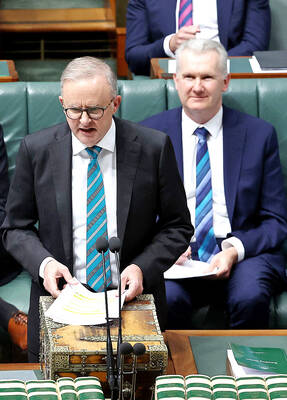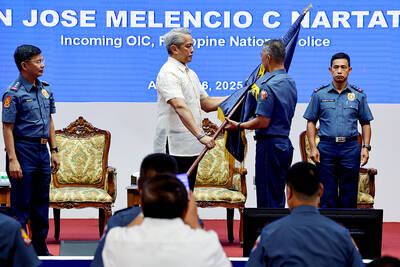How do you count scorpions?
Very gingerly, it turns out.
“You use tongs and pick them up by the stinger,” London Zoo senior keeper Tony Dobbs said on Thursday. “You avoid the pincers at all costs. You could get a nasty nick if you’re not counting carefully.”

PHOTO: AFP
Thursday was counting day at the London Zoo, so Dobbs not only had to count scorpions (13) but also the zoo’s meerkats, millipedes and many other animals.
The annual count is a legal requirement for all British zoos, and it’s also a useful tool for monitoring animal conservation efforts.
Zookeepers say it makes sense to have a census.
“We have to tell the zoo licensing authorities exactly how many animals we have,” zoological director David Field said, standing next to the manmade otters’ pond. “It’s not just the number of animals, it’s who we’ve got, because many of our animals are individually identifiable.”
Counting some of the London Zoo’s more than 650 species is easy.
There’s only one giraffe, hard to miss. But other tasks are not for the squeamish: Who really wants to spend a few hours determining if the population of 612 cockroaches has grown since last year?
All the information collected from British zoos is sent to a global animal-monitoring database run by a nonprofit group known as ISIS, the International Species Information System.
This treasure trove of updated data about animals throughout the world is used by the London Zoo and hundreds of others trying to monitor the threat to various species.
“This information forms the essential scientific foundation for the management of our conservation breeding programs,” Field said.
The tally is particularly important when dealing with species that have become extinct in the wild.
Miranda Stevenson, director of the British and Irish Association of Zoos and Aquariums, said the information could be used to help develop effective breeding programs for species like the Socorro doves, which are no longer found in the wild.
“When zoos submit data to these central databases, it means that we can run detailed and scientifically based breeding programs to safeguard these valuable and threatened species,” she said.
Some of the counts are actually pleasant. Dobbs had no trouble tallying three meerkats in a spacious enclosure on Thursday, although they did seem nervous when he walked in carrying a clipboard. They hid in tunnels and behind bushes until they saw the scraps of food he was carrying. After 10 minutes, they were practically sitting in his lap.
“Once they realized there was no threat, they were fine,” Dobbs said.
But other species offer a formidable challenge.
Piranha, for example, are very difficult to count, not just because of their strong jaws and impressive teeth, but because of their speed in the water.
“They can be quite tricky because they move around the tank very fast,” Dobbs said. “It’s can be a nightmare to count 20 fish. But to be honest they’re not as dangerous as people think, as long as they’re well fed.”
He said keepers are, nonetheless, cautious about getting too close to the Amazonian fish during the counting process.
“We tend to avoid putting too much flesh into the tank, just in case,” he said.
They count each of the fregate beetles and rare partula snails one by one, but with some species, zookeepers have to compromise rather than getting a precise figure.
Field said, for example, that no one is required to count each and every leafcutter ant — an estimate based on the exact number of ant colonies will just have to do.
He is particularly proud of two additions counted in the new census: Harry, the first warthog born at the London Zoo in roughly a century, and Conchita, an extremely rare white-naped mangabey monkey born in April by cesarean section.
The survival of her species is very much in doubt because of the threat to its habitat in West Africa, making the survival of Conchita even more important, Field said.
“She’s so endangered we needed to hand-rear her,” he said.
“She’s now been integrated back into the group. That’s a tremendous success,” he said.

Australia has announced an agreement with the tiny Pacific nation Nauru enabling it to send hundreds of immigrants to the barren island. The deal affects more than 220 immigrants in Australia, including some convicted of serious crimes. Australian Minister of Home Affairs Tony Burke signed the memorandum of understanding on a visit to Nauru, the government said in a statement on Friday. “It contains undertakings for the proper treatment and long-term residence of people who have no legal right to stay in Australia, to be received in Nauru,” it said. “Australia will provide funding to underpin this arrangement and support Nauru’s long-term economic

‘NEO-NAZIS’: A minister described the rally as ‘spreading hate’ and ‘dividing our communities,’ adding that it had been organized and promoted by far-right groups Thousands of Australians joined anti-immigration rallies across the country yesterday that the center-left government condemned, saying they sought to spread hate and were linked to neo-Nazis. “March for Australia” rallies against immigration were held in Sydney, and other state capitals and regional centers, according to the group’s Web site. “Mass migration has torn at the bonds that held our communities together,” the Web site said. The group posted on X on Saturday that the rallies aimed to do “what the mainstream politicians never have the courage to do: demand an end to mass immigration.” The group also said it was concerned about culture,

ANGER: Unrest worsened after a taxi driver was killed by a police vehicle on Thursday, as protesters set alight government buildings across the nation Protests worsened overnight across major cities of Indonesia, far beyond the capital, Jakarta, as demonstrators defied Indonesian President Prabowo Subianto’s call for calm. The most serious unrest was seen in the eastern city of Makassar, while protests also unfolded in Bandung, Surabaya, Solo and Yogyakarta. By yesterday morning, crowds had dispersed in Jakarta. Troops patrolled the streets with tactical vehicles and helped civilians clear trash, although smoke was still rising in various protest sites. Three people died and five were injured in Makassar when protesters set fire to the regional parliament building during a plenary session on Friday evening, according to

Philippine President Ferdinand Marcos Jr has fired his national police chief, who gained attention for leading the separate arrests of former Philippine president Rodrigo Duterte on orders of the International Criminal Court and televangelist Apollo Carreon Quiboloy, who is on the FBI’s most-wanted list for alleged child sex trafficking. Philippine Executive Secretary Lucas Bersamin did not cite a reason for the removal of General Nicolas Torre as head of the 232,000-member national police force, a position he was appointed to by Marcos in May and which he would have held until 2027. He was replaced by another senior police general, Jose